 What kind of man would defy a king?
Every man dies, not every man really lives.
His passion captivated a woman.
His courage inspired a nation. His heart defied a king.
What kind of man would defy a king?
Every man dies, not every man really lives.
His passion captivated a woman.
His courage inspired a nation. His heart defied a king.

Braveheart
is a storm-the-castle spectacle about a legendary 13th-century Scottish
hero William Wallace. It is story of that time, when men were men, and
no one needed special license to take off an enemy's arm with a broadsword.
Time when William Wallace, the fierce Scottish lord, rebells against the
English in massive Scot-Brit battles and he became the greatest hero of
Scotland. "Braveheart" is a movie that is grandiose and epic as
well as classic. Mel
Gibson and screenwriter Randall
Wallace do not stray from the traditional epic format. The film
has all the textbook features: panoramic shots, bold and sweeping themes,
a protagonist of heroic proportions, a larger than life treatment, and
a long running time.
 The film covers the life of William
Wallace from the time as a small boy when his Father dies to his
own death. Set mostly in 13th Century Scotland with a background of struggle
against the unjust rule of the English King, Longshanks, the film gradually
grows in scope from a small boy's tragedy to a National conflict spanning
generations. After the death of his Father at the hands of the English,
William is raised by his uncle, who being a great believer in education,
takes William across the world were he learns Latin and French and the
manly arts of war. But he eventually returns to his homeland. A fully mature
man now, he is ready to settle down with his childhood sweetheart and raise
a family. The concerns of his countrymen over English rule take second
place to his pursuit of the beautiful Murron. Due to the half-hearted opposition
of Murron's Father and the English noble's rights to take a bride on her
wedding night, Wallace is married in secret. The honeymoon doesn't last
long as their joy is shattered by the results of an English soldiers attempted
rape of Murron. While William is able to beat back the soldiers from his
wife, she is captured as they both flee in separate directions. The local
Lord then decides to bring Wallace into the open by executing his woman
in a particularly brutal scene where she is tied to an upright pole and
her throat is cut. So starts William Wallace's life
long battle against the English to free the people of Scotland.
This common man is able to successfully organize the local villagers to
overthrow the local fort and slaughter the
The film covers the life of William
Wallace from the time as a small boy when his Father dies to his
own death. Set mostly in 13th Century Scotland with a background of struggle
against the unjust rule of the English King, Longshanks, the film gradually
grows in scope from a small boy's tragedy to a National conflict spanning
generations. After the death of his Father at the hands of the English,
William is raised by his uncle, who being a great believer in education,
takes William across the world were he learns Latin and French and the
manly arts of war. But he eventually returns to his homeland. A fully mature
man now, he is ready to settle down with his childhood sweetheart and raise
a family. The concerns of his countrymen over English rule take second
place to his pursuit of the beautiful Murron. Due to the half-hearted opposition
of Murron's Father and the English noble's rights to take a bride on her
wedding night, Wallace is married in secret. The honeymoon doesn't last
long as their joy is shattered by the results of an English soldiers attempted
rape of Murron. While William is able to beat back the soldiers from his
wife, she is captured as they both flee in separate directions. The local
Lord then decides to bring Wallace into the open by executing his woman
in a particularly brutal scene where she is tied to an upright pole and
her throat is cut. So starts William Wallace's life
long battle against the English to free the people of Scotland.
This common man is able to successfully organize the local villagers to
overthrow the local fort and slaughter the 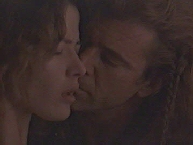 magistrate
that killed his wife, in an identical manner. Then, with the help of the
adjacent clan, he goes on to tear down the local Lord's short term castle
and allow one of the cuckolded husbands to take his revenge. Meanwhile
King Longshanks is distracted by his war with France and allows his week
son an opportunity to prove himself by bringing Wallace to English justice.
The Son's ineptness soon leads to full scale battle. A situation that requires
the support of the Scottish Lords, an infighting self interested bunch
of old men. On the occasion of the first major battle Wallace is able to
maneuver three Lords into helping while stealing the hearts of their levees.
Through the use of some brilliant tactics he successfully defeats the English
forces and his legend grows to new heights.
magistrate
that killed his wife, in an identical manner. Then, with the help of the
adjacent clan, he goes on to tear down the local Lord's short term castle
and allow one of the cuckolded husbands to take his revenge. Meanwhile
King Longshanks is distracted by his war with France and allows his week
son an opportunity to prove himself by bringing Wallace to English justice.
The Son's ineptness soon leads to full scale battle. A situation that requires
the support of the Scottish Lords, an infighting self interested bunch
of old men. On the occasion of the first major battle Wallace is able to
maneuver three Lords into helping while stealing the hearts of their levees.
Through the use of some brilliant tactics he successfully defeats the English
forces and his legend grows to new heights.
| WILLIAM
WALLACE (1267 - 1305) |
William Wallace is
perhaps the greatest hero of the Scottish people.
His legend inspired 100,000 people to gather on June 24, 1861, 556 years
after his death, at the opening ceremony of the 300-foot National Monument
in Stirling that continues to honorhis memory. It was here Wallace once
led a band of desperate and outnumbered Scots to a glorious victory over
the English.
The fabled five-foot
sword that once belonged to Wallace is on display in Stirling Castle. Born
around the year 1267, Wallace was the second son of Malcolm Wallace, a
middle-class landowner who was educated and spoke three languages. William
Wallace was educated at Paisley Abbey by his uncle but little is recorded
of his day-today life. It is believed he once sent to the Pope to plead
for Scotland's freedom and, while guardian of Scotland, attempted to develop
trade for his country. Material wealth was of no intrest to Wallace, who
refused the Crown of Scotland when it was offered to him. While the Scottish
nobles around him were accepting lands and titles from the English King,
Wallace remained committed to freedom and honor for Scotland.
The main
source of his legends come from 300 pages of rhyming verse attributed to
a blind poet known as 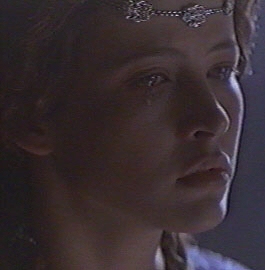 Blind
Harry, who could neither read nor write. The work is said to be taken from
the diary of Wallace's chaplain, Mr. Blair, who was always at his side.
According to the Encyclopedia Britannica,
the legends of Wallace indicate the passions his story is able to arouse
more than hard fact; however, it was these exciting tales that inspired
Randall Wallace to write the screenplay for
"Braveheart." Screenwriter Randall Wallace believes his screenplay for
"Braveheart" captures the spirit of William Wallace in bringing to the
screen the hero whose story has gone untold for too long.
Blind
Harry, who could neither read nor write. The work is said to be taken from
the diary of Wallace's chaplain, Mr. Blair, who was always at his side.
According to the Encyclopedia Britannica,
the legends of Wallace indicate the passions his story is able to arouse
more than hard fact; however, it was these exciting tales that inspired
Randall Wallace to write the screenplay for
"Braveheart." Screenwriter Randall Wallace believes his screenplay for
"Braveheart" captures the spirit of William Wallace in bringing to the
screen the hero whose story has gone untold for too long.
"History is impressionistic,"
says Randall Wallace. "What William Wallace did can be inferred from
the passion of his supporters and the hatred of his enemies. The great
legends about him built a fire in my heart. His life communicated that
you will prevail if you are faithful to what you believe in; and if those
you love believe in you. Your body can be broken but not your spirit."
When the writer is asked if he might be a descendent of William Wallace,
he replies, "I don't know in fact, but in spirit I am - and spirit is
greater than fact."
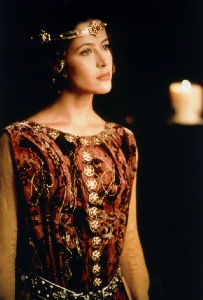 Mel Gibson directs with a lot of brilliancy
a brilliant cast. Patrick
McGoohan has a very nice performance as Edward I, the King Longshank.
The scene when he waits for the death and loses his voice is really good.
And now hurry to our favourite part of cast: Sophie
Marceau, as princess Isabelle, has along the movie no more than
fifteen minutes of performance but Mel Gibson gave to those minutes such
a very special treatment that princess Isabelle soon becomes
one of the major characters in "Braveheart". This role was her
first English-speaking part. Asked why Mel Gibson chose Sophie for the
character of Princess Isabelle, Mel Gibson replied: "Well, she's beautiful,
she's French and she's a good actress. The character needed to be at least
two of those things."
Mel Gibson directs with a lot of brilliancy
a brilliant cast. Patrick
McGoohan has a very nice performance as Edward I, the King Longshank.
The scene when he waits for the death and loses his voice is really good.
And now hurry to our favourite part of cast: Sophie
Marceau, as princess Isabelle, has along the movie no more than
fifteen minutes of performance but Mel Gibson gave to those minutes such
a very special treatment that princess Isabelle soon becomes
one of the major characters in "Braveheart". This role was her
first English-speaking part. Asked why Mel Gibson chose Sophie for the
character of Princess Isabelle, Mel Gibson replied: "Well, she's beautiful,
she's French and she's a good actress. The character needed to be at least
two of those things."
"Sophie Marceau, wearing a headdress that,
under the crown, looks like white cerebra," saying on the other hand
critic Ralph Benner in his review.
Critics
also liked the performances of Angus
MacFadyen, as Robert the  Bruce,
and, of course, Mel Gibson, as William Wallace. However, they said the
Mel Gibson's work as director was much better than his work as actor. Besides
Sophie you can see another exceedingly attractive co-star - Catherine
McCormack in the role of nice Murron.
Bruce,
and, of course, Mel Gibson, as William Wallace. However, they said the
Mel Gibson's work as director was much better than his work as actor. Besides
Sophie you can see another exceedingly attractive co-star - Catherine
McCormack in the role of nice Murron.
"Despite limited screen time, McCormack and
Marceau produce such striking characterizations that Braveheart fairly
can be described as a love story," means Mike Townsend - critic.
Braveheart
tempers moments of despair with deliriously romantic passages abetted by
James
Horner's traditionally lush score and
photography by John
Toll (Legends of the Fall's Oscar winner).
One of the critics, Rui Sadio, said: "When we join that music
to the beautiful Scotch landscapes, view by the camera of John Toll, then
we realize all the beauty of this film. Braveheart is, in my opinion, one
of the best movies of 1995"
The
screenplay for "Braveheart" by Randall Wallace
was brought to the attention of Mel Gibson and his associates Bruce Davey
and Stephen McEveety by Alan Ladd, Jr. Gibson remembers, "I couldn't
wait to turn each page and was surprised at every turn. The screenplay
had everything - heroic battles, a powerful love story and the passion
of one man's strength which fires a whole country against its aggressors."
Screenwriter Randall Wallace and his wife were on vacation in Edinburgh
when he glimpsed a statue of William Wallace and learned some of the legends
about him. He began to research and discovered that beyond the preponderance
of legends, very few actual facts are known about him. His work on the
screenplay for "Braveheart" commenced after reading a 1740 English translation
of rhyming Scottish verse presenting legends about Wallace.
The
production's subsequent base of operations was Dublin, 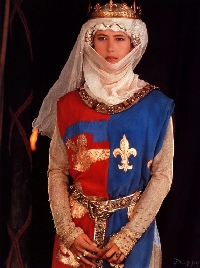 Ireland for 15 weeks. This area was selected when it became apparent that
everything needed for the shoot could be found within a 30-mile radius,
along with a convenient airport. For scenes of the savage battles of Stirling
and Falkirk, 1,700 of the Irish Army's reserve forces acted as the infantry,
archery and cavalry divisions of the Scottish and English armies in the
late 13th and early I4th centuries. The expanses required for the battle
scenes were found at the Gurragh and Ballymore Eustace, a privately owned
stretch of land; in the vicinity of medieval castles at Trim and Dunsoghly;
and at the large studio tract at Ardmore.
Twelve
weeks of building, painting and plastering transformed the exterior of
Trim Castle into the fortified English town
of York with the addition of seven-ton gates and the replacement of wooden
buttresses. On the other side of the massive wall, a London square was
created. Dunsoghly Castle provided the exterior for the film's Edinburgh
Castle. Built around the middle of the 15th century by Sir Thomas Plunkett,
the castle's original yet partially restored wooden roof is the last surviving
example of its kind in Ireland. For eight weeks prior to filming at Dunsoghly
Castle, Tom Sanders and his team transformed the solitary stone structure
into a busy hustling castle with 30-foot-high battlements, a drawbridge,
a great hall and peripheral 'A' frame houses with pitched-roofs.
Ireland for 15 weeks. This area was selected when it became apparent that
everything needed for the shoot could be found within a 30-mile radius,
along with a convenient airport. For scenes of the savage battles of Stirling
and Falkirk, 1,700 of the Irish Army's reserve forces acted as the infantry,
archery and cavalry divisions of the Scottish and English armies in the
late 13th and early I4th centuries. The expanses required for the battle
scenes were found at the Gurragh and Ballymore Eustace, a privately owned
stretch of land; in the vicinity of medieval castles at Trim and Dunsoghly;
and at the large studio tract at Ardmore.
Twelve
weeks of building, painting and plastering transformed the exterior of
Trim Castle into the fortified English town
of York with the addition of seven-ton gates and the replacement of wooden
buttresses. On the other side of the massive wall, a London square was
created. Dunsoghly Castle provided the exterior for the film's Edinburgh
Castle. Built around the middle of the 15th century by Sir Thomas Plunkett,
the castle's original yet partially restored wooden roof is the last surviving
example of its kind in Ireland. For eight weeks prior to filming at Dunsoghly
Castle, Tom Sanders and his team transformed the solitary stone structure
into a busy hustling castle with 30-foot-high battlements, a drawbridge,
a great hall and peripheral 'A' frame houses with pitched-roofs.
Other
"Braveheart" locations in Ireland include
the ruins of Bective Abbey, which became the courtyard of Longshanks' castle
and the dungeon where William is incarcerated; Coronation Plantation, where
filming was done in and around an old hunting lodge after another English
stockade was erected by the company; and the ruined St. Nicholas Church,
Dunsany Castle - believed to have been built in the 12th century - was
extensively modified to become Westminster Abbey for the filmmakers. At
Blessington Lakes, a 45 foot-high tower was erected in seven-foot-deep
water to depict the view from a window in Mornay's castle. Here, Wallace
spurs his horse to jump through the window to make a daring escape. Some
interior sets for "Braveheart" were filmed at Ardmore Studios stages, while
the Edinburgh Council chamber was used for a scene set in Mornay's castle.
Principal photography concluded on October 29, 1994.
Braveheart was reportedly budgeted
at 70 million USD. Most of this horible sume
of money consupted scenes involving hundreds of actors, hundreds of properties,
tousand of work hours spend to perfect costume and make-up preparations
of actors. This film was expensive! And profitable, too, fortunately.
It's
clear that the production is at least as large as the movie's legendary
subject: the press kit quotes the Encyclopedia Britannica and boasts separate
sections for "Battle Sequences,'' "Art and Design,'' "Costumes,'' and "The
World of 'Braveheart,''' listing stats as
measures of "authenticity'' and scope: "1700
of the Irish Army's reserve forces acted as the infantry,'' "10,000 arrows
with rubber tips,'' "40-foot flames,'' "6000 costumes,'' and "3000 meters
of plaid were woven in eight different colors.
Here
I offer you some opinions from renomed or not critics. Here you can find
positive critics and negative ones, too. Decide, which you will believe
in and whoose critic has the same opinion as you. And the best you can
do is seeing "Braveheart". I mean it is NOT bad film at any case. And with
SOPHIE! :-)
Braveheart
is, in fact, a magnificent and magisterial
film. For three hours we are completely absorbed by the narrative's rhytm
which never gives place to a single moment of monotony or uninterest.
Rui Sadio
The
archers, calvary, and infantry provide a 13th century version of a football
kickoff; there is even Wallace's Knute Rockne like pep talk. The
hand-to-hand combat is choreographed rather than directed, and the strategies
unfold gradually, giving viewers the feeling of watching a lawn chess match
using people as pieces. Viewers expecting historical epics to be historically
accurate will be disappointed by what is added to, and deleted from, the
film's Wallace. Most of the violence is quick or off screen, and
many of the most gruesome types of incidents have appeared in other mainstream
films. Nonetheless, the sheer volume of mayhem combined with the intense
emotional tone of the film will leave few unaffected.
Mike Townsend
Braveheart
is a brutal, bloody motion picture, but the
violence is not gratuitous. The maimings, decapitations, and other assorted
gruesome details make Wallace's world seem real and immediate. In addition,
few theatrical moments make a more eloquent statement against war than
when Gibson shows women and children weeping over the dead on a body-littered
battlefield. War is a two-headed beast, and both faces -- the glorious
and the tragic -- are depicted.
James Berardinelli
Director-star
Mel Gibson spent a lot of nights studying up on Spartacus, the screen's
most emotional Roman saga.
Budget-busting
historical blockbusters mostly belong to decades past, when the leads were
often more rigid than their armor. But as Scotland's William Wallace, Gibson
is crucially charismatic leading peasants against England's Edward I, achieving
remarkable success until lack of support by toadying countrymen restores
the cruel king's advantage.
Mike Clark, USA TODAY
Curiously,
this film seems less anachronistic
than its trailers made it feel. Occasional lines seem, if not out of place,
at least loverly fine-tuned for the late 20th Century. Having characters
exclaiming "Excellent!" seems better attuned to the time of Bill and Ted
than of William and Edward. Gibson's visual style seems not yet matured
so that he overuses slow motion scenes, sometimes telegraphing the action.
Some of his scenes seem contrived and unbelievable. One such scene involves
a head body that drips blood just at perfect instant. Another involves
what has to be the world's least skittish deer. (You have to have seen
the film to know what I mean.)
In fact, while the film seems to say that Wallace
was trained to use his wits in battle rather than brute force, that is
not how he is portrayed on the screen. The historical Wallace used his
wits far more in battle than Gibson's representation, who seems to rely
on a good speech and little more than headlong berserker assaults.
Mark R. Leeper
Braveheart
may not be an historically corrected movie but the nature of its message
make us think about the importance that we give to Liberty, nowadays.
Braveheart
is, in fact, a magnificent and magisterial film. For three hours we are
completely absorbed by the narrative's rhytm which never gives place to
a single moment of monotony or uninterest.
Rui Sadio
Gibson
has proved that he is a competent director, capable of handling ambitious
projects with large casts and big production costs. He has created a completely
adequate modern facsimile
of the classic romantic epic.
Hal Hinson
Braveheart is rated R for considerable violence
and gore, a rape scene, sex, nudity, profanity and vulgarity.
In the years
just preceding William Wallace's revolt Edward I knew his real enemy was
France to the south with a military force much superior to his own. England
had been at peace with Scotland for more than a century and Edward expected
little trouble from the north. But John de Balliol, King of Scotland, allied
himself with Philip IV of France rather than supply Edward with men and
arms to fight the French. It was not a strong alliance since France had
little faith in John's power to defend his title as king.
Edward
was already taxing England for the war with France and did not relish the
idea of fighting a war against Scotland and France at the same time. He
certainly did not want to tax his people for both. In 1290
he had expelled the Jews from England and without them to borrow from any
more he was finding that the decision to expel had been a costly one. Edward
decided to confer with Scotland's King John and to assure John's loyalty.
He called upon John to meet him at Berwick. John refused. Edward took this
as a declaration of war and invaded Scotland with intent to conquer, sacking
Berwick. King John then renounced any homage to England. But Edward's commander,
Warenne, the Earl of Surrey, defeated King John at the Battle of Dunbar.
He captured John and imprisoned him. Edward declared himself to be King
of Scotland before returning to fight France.
Edward
set up a puppet government in Scotland, not expecting much resistance.
William Wallace, the son of a poor knight,
was outlawed at this time when he got into a personal argument with a young
Englishman. The Englishman Selby insulted Wallace and Wallace killed him.
Wallace joined one of the several bands of outlaws. With a band of 30 men
he burned Lanark and killed the sheriff in May 1297.
Wallace
organized an army from the small landowners and organized guerilla
attacks on the English between Forth and Tay. Through this time
Edward was fighting in France and Wallace was fighting the Earl of Surrey.
Surrey brought a large army to fight Wallace in September. The two armies
met September 11, 1297, at the Battle at Cambuskenneth
(a.k.a. Stirling) ridge near Forth. (This is very different from
how the battle was portrayed in the film.) A narrow bridge separated the
two armies.
The Earl's own advisors told him that he could not get his full army
across the bridge in under eleven hours and if he tried crossing he could
bring only a small part of his army to bear on defense. He ignored the
advice and ordered him men across the bridge. Wallace awaited the proper
time, when about half the army was across the bridge, and attacked. Half
the army watched helpless on the far bank as the other was driven back
into the river to drown. Wallace earned a stunning victory and in the process
captured Stirling Castle.
Edward
made a truce with France by marrying the king's sister and betrothing the
king's daughter to his son. He was off in Flanders when he found out that
Wallace had defeated his army and, flushed with victory, had invaded England
and was sacking Cumberland and North Umberland. Wallace was knighted and
given the guardianship of Scotland ruled in Balliol's name. He decorated
his shield with the skin of an English tax-collector.
Edward
I, having his truce with France, re-invaded Scotland, marched to Stirling,
and met Wallace's army at Falkirk on July 22, 1298. Wallace formed his
forces into four schiltrons. That is a circle of men with spears pointed
outward (similar to what the film showed at Battle of Stirling Bridge,
but that was a straight line). Edward's knights could do little against
these phalanxes and so were called off. Instead the English used a shower
of arrows from long bows. This made quick work of the Scottish army. Wallace,
however, survived by hiding in a dense nearby wood.
Wallace
resigned his guardianship, but still fought a guerrilla war against the
English in Scotland. In 1305 he was arrested
at Robroyston near Glasgow. He was found guilty of being a traitor to Edward,
though he had never sworn allegiance to the king.
He
was executed that same year, much in the manner shown in the film. Contrary
to the film, however, Edward I did not die until 1307, Edward II
did not marry until 1308, and Edward II's and Isabella's first child was
Edward III who was not born until 1310. Henry the Minstrel, also known
as "Blind Harry" made Wallace a popular hero by immortalizing him in an
epic romance poem in the 15th Century.
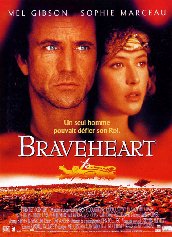
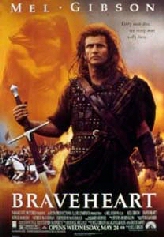
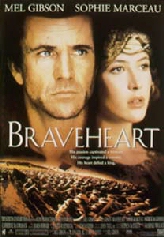
You
can download file bravehrt.mid (2970B), not
very good mid-interpretation of head music motif. But, have we some better?
;-)
Yes
we have! From now (7.1.99) I offer you braveheart.zip,
(44MHz, 16bit stereo, 1.6MB m_p_three ;) second track from the Braveheart
CD (see below) named "A Gift of a Thistle". Download and enjoy.
Try
to use Jospain's
Sophie Marceau Winamp skin.
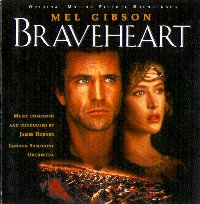 In 1995 The Decca Records company limited released CD (or LP
if you want) with music from 'Braveheart'. It containts 18 compositions
from silent and melodic 'Gift of a Thistle' (You can download this track
in MP3 format above) to rolling 'Attack on Murron'. Melodious, scotish
and grave is this music composed by James Horner. All music is performed
by world famous and well known London Symphony Orchestra
and right so it sounds. Silently and loudly, melodious and rhythmic, too.
Especially 'Sons of Scotland' sound magnificently!
us.imdb.com -
What International Movie Database says about "Braveheart"?
In 1995 The Decca Records company limited released CD (or LP
if you want) with music from 'Braveheart'. It containts 18 compositions
from silent and melodic 'Gift of a Thistle' (You can download this track
in MP3 format above) to rolling 'Attack on Murron'. Melodious, scotish
and grave is this music composed by James Horner. All music is performed
by world famous and well known London Symphony Orchestra
and right so it sounds. Silently and loudly, melodious and rhythmic, too.
Especially 'Sons of Scotland' sound magnificently!
us.imdb.com -
What International Movie Database says about "Braveheart"?
voyager.paramount.com
- Official page dedicated to "Braveheart".
page optimalized
for Netscape Communicator 4.0,
screen resolution 800x600,
author: Jospain

 The film covers the life of William
Wallace from the time as a small boy when his Father dies to his
own death. Set mostly in 13th Century Scotland with a background of struggle
against the unjust rule of the English King, Longshanks, the film gradually
grows in scope from a small boy's tragedy to a National conflict spanning
generations. After the death of his Father at the hands of the English,
William is raised by his uncle, who being a great believer in education,
takes William across the world were he learns Latin and French and the
manly arts of war. But he eventually returns to his homeland. A fully mature
man now, he is ready to settle down with his childhood sweetheart and raise
a family. The concerns of his countrymen over English rule take second
place to his pursuit of the beautiful Murron. Due to the half-hearted opposition
of Murron's Father and the English noble's rights to take a bride on her
wedding night, Wallace is married in secret. The honeymoon doesn't last
long as their joy is shattered by the results of an English soldiers attempted
rape of Murron. While William is able to beat back the soldiers from his
wife, she is captured as they both flee in separate directions. The local
Lord then decides to bring Wallace into the open by executing his woman
in a particularly brutal scene where she is tied to an upright pole and
her throat is cut. So starts William Wallace's life
long battle against the English to free the people of Scotland.
This common man is able to successfully organize the local villagers to
overthrow the local fort and slaughter the
The film covers the life of William
Wallace from the time as a small boy when his Father dies to his
own death. Set mostly in 13th Century Scotland with a background of struggle
against the unjust rule of the English King, Longshanks, the film gradually
grows in scope from a small boy's tragedy to a National conflict spanning
generations. After the death of his Father at the hands of the English,
William is raised by his uncle, who being a great believer in education,
takes William across the world were he learns Latin and French and the
manly arts of war. But he eventually returns to his homeland. A fully mature
man now, he is ready to settle down with his childhood sweetheart and raise
a family. The concerns of his countrymen over English rule take second
place to his pursuit of the beautiful Murron. Due to the half-hearted opposition
of Murron's Father and the English noble's rights to take a bride on her
wedding night, Wallace is married in secret. The honeymoon doesn't last
long as their joy is shattered by the results of an English soldiers attempted
rape of Murron. While William is able to beat back the soldiers from his
wife, she is captured as they both flee in separate directions. The local
Lord then decides to bring Wallace into the open by executing his woman
in a particularly brutal scene where she is tied to an upright pole and
her throat is cut. So starts William Wallace's life
long battle against the English to free the people of Scotland.
This common man is able to successfully organize the local villagers to
overthrow the local fort and slaughter the  magistrate
that killed his wife, in an identical manner. Then, with the help of the
adjacent clan, he goes on to tear down the local Lord's short term castle
and allow one of the cuckolded husbands to take his revenge. Meanwhile
King Longshanks is distracted by his war with France and allows his week
son an opportunity to prove himself by bringing Wallace to English justice.
The Son's ineptness soon leads to full scale battle. A situation that requires
the support of the Scottish Lords, an infighting self interested bunch
of old men. On the occasion of the first major battle Wallace is able to
maneuver three Lords into helping while stealing the hearts of their levees.
Through the use of some brilliant tactics he successfully defeats the English
forces and his legend grows to new heights.
magistrate
that killed his wife, in an identical manner. Then, with the help of the
adjacent clan, he goes on to tear down the local Lord's short term castle
and allow one of the cuckolded husbands to take his revenge. Meanwhile
King Longshanks is distracted by his war with France and allows his week
son an opportunity to prove himself by bringing Wallace to English justice.
The Son's ineptness soon leads to full scale battle. A situation that requires
the support of the Scottish Lords, an infighting self interested bunch
of old men. On the occasion of the first major battle Wallace is able to
maneuver three Lords into helping while stealing the hearts of their levees.
Through the use of some brilliant tactics he successfully defeats the English
forces and his legend grows to new heights.
 Blind
Harry, who could neither read nor write. The work is said to be taken from
the diary of Wallace's chaplain, Mr. Blair, who was always at his side.
According to the Encyclopedia Britannica,
the legends of Wallace indicate the passions his story is able to arouse
more than hard fact; however, it was these exciting tales that inspired
Randall Wallace to write the screenplay for
"Braveheart." Screenwriter Randall Wallace believes his screenplay for
"Braveheart" captures the spirit of William Wallace in bringing to the
screen the hero whose story has gone untold for too long.
Blind
Harry, who could neither read nor write. The work is said to be taken from
the diary of Wallace's chaplain, Mr. Blair, who was always at his side.
According to the Encyclopedia Britannica,
the legends of Wallace indicate the passions his story is able to arouse
more than hard fact; however, it was these exciting tales that inspired
Randall Wallace to write the screenplay for
"Braveheart." Screenwriter Randall Wallace believes his screenplay for
"Braveheart" captures the spirit of William Wallace in bringing to the
screen the hero whose story has gone untold for too long.
 Mel Gibson directs with a lot of brilliancy
a brilliant cast. Patrick
McGoohan has a very nice performance as Edward I, the King Longshank.
The scene when he waits for the death and loses his voice is really good.
And now hurry to our favourite part of cast: Sophie
Marceau, as princess Isabelle, has along the movie no more than
fifteen minutes of performance but Mel Gibson gave to those minutes such
a very special treatment that princess Isabelle soon becomes
one of the major characters in "Braveheart". This role was her
first English-speaking part. Asked why Mel Gibson chose Sophie for the
character of Princess Isabelle, Mel Gibson replied: "Well, she's beautiful,
she's French and she's a good actress. The character needed to be at least
two of those things."
Mel Gibson directs with a lot of brilliancy
a brilliant cast. Patrick
McGoohan has a very nice performance as Edward I, the King Longshank.
The scene when he waits for the death and loses his voice is really good.
And now hurry to our favourite part of cast: Sophie
Marceau, as princess Isabelle, has along the movie no more than
fifteen minutes of performance but Mel Gibson gave to those minutes such
a very special treatment that princess Isabelle soon becomes
one of the major characters in "Braveheart". This role was her
first English-speaking part. Asked why Mel Gibson chose Sophie for the
character of Princess Isabelle, Mel Gibson replied: "Well, she's beautiful,
she's French and she's a good actress. The character needed to be at least
two of those things."
 Bruce,
and, of course, Mel Gibson, as William Wallace. However, they said the
Mel Gibson's work as director was much better than his work as actor. Besides
Sophie you can see another exceedingly attractive co-star - Catherine
McCormack in the role of nice Murron.
Bruce,
and, of course, Mel Gibson, as William Wallace. However, they said the
Mel Gibson's work as director was much better than his work as actor. Besides
Sophie you can see another exceedingly attractive co-star - Catherine
McCormack in the role of nice Murron.
 Ireland for 15 weeks. This area was selected when it became apparent that
everything needed for the shoot could be found within a 30-mile radius,
along with a convenient airport. For scenes of the savage battles of Stirling
and Falkirk, 1,700 of the Irish Army's reserve forces acted as the infantry,
archery and cavalry divisions of the Scottish and English armies in the
late 13th and early I4th centuries. The expanses required for the battle
scenes were found at the Gurragh and Ballymore Eustace, a privately owned
stretch of land; in the vicinity of medieval castles at Trim and Dunsoghly;
and at the large studio tract at Ardmore.
Ireland for 15 weeks. This area was selected when it became apparent that
everything needed for the shoot could be found within a 30-mile radius,
along with a convenient airport. For scenes of the savage battles of Stirling
and Falkirk, 1,700 of the Irish Army's reserve forces acted as the infantry,
archery and cavalry divisions of the Scottish and English armies in the
late 13th and early I4th centuries. The expanses required for the battle
scenes were found at the Gurragh and Ballymore Eustace, a privately owned
stretch of land; in the vicinity of medieval castles at Trim and Dunsoghly;
and at the large studio tract at Ardmore.



 In 1995 The Decca Records company limited released CD (or LP
if you want) with music from 'Braveheart'. It containts 18 compositions
from silent and melodic 'Gift of a Thistle' (You can download this track
in MP3 format above) to rolling 'Attack on Murron'. Melodious, scotish
and grave is this music composed by James Horner. All music is performed
by world famous and well known London Symphony Orchestra
and right so it sounds. Silently and loudly, melodious and rhythmic, too.
Especially 'Sons of Scotland' sound magnificently!
In 1995 The Decca Records company limited released CD (or LP
if you want) with music from 'Braveheart'. It containts 18 compositions
from silent and melodic 'Gift of a Thistle' (You can download this track
in MP3 format above) to rolling 'Attack on Murron'. Melodious, scotish
and grave is this music composed by James Horner. All music is performed
by world famous and well known London Symphony Orchestra
and right so it sounds. Silently and loudly, melodious and rhythmic, too.
Especially 'Sons of Scotland' sound magnificently!